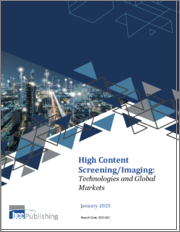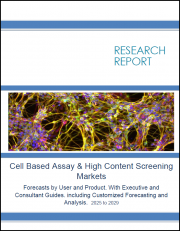
|
시장보고서
상품코드
1327505
HCS(High Content Screening) 시장 규모 및 점유율 분석 - 성장 동향과 예측(2023-2028년)High Content Screening Market Size & Share Analysis - Growth Trends & Forecasts (2023 - 2028) |
||||||
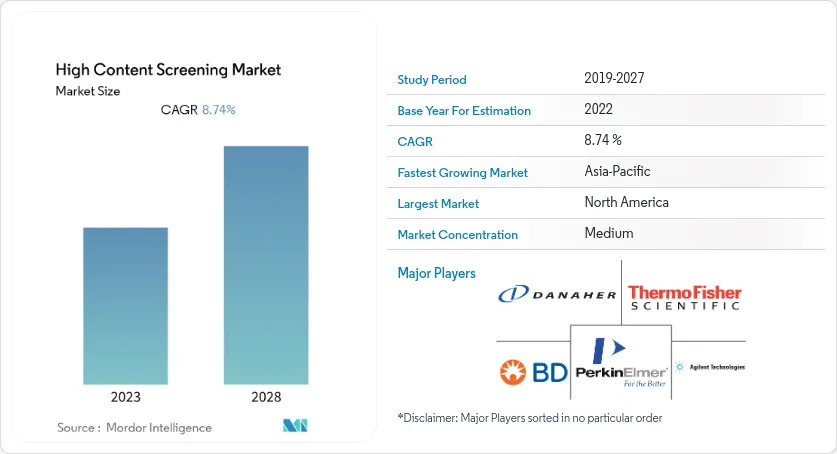
고함량 검사 시장은 예측 기간 동안 8.74%의 CAGR을 나타낼 것으로 예상됩니다.
대부분의 바이오제약 기업들이 SARS-CoV-2 바이러스에 대한 새로운 치료제 시장 개척에 몰두하고 있었기 때문에 코로나19 사태는 HCS(High Content Screening) 시장에 스포트라이트를 비추었습니다. 신약 개발이 증가함에 따라 특정 백신을 시판하기 전에 독성을 모니터링하고 평가하기 위해 약물 검사 제품 및 서비스에 대한 수요가 증가했습니다. 2020년 미국화학회 약리학 및 중개과학(American Chemical Society Pharmacology and Translational Science)에 게재된 연구 논문에 따르면, 가상 스크리닝과 실험적 스크리닝을 결합하는 전략으로 가상 스크리닝과 실험적 스크리닝을 결합한 전략으로 확인된 코로나19에 대한 새로운 잠재적 치료제는 이미 승인된 약물 중에서 선택된 약 4,000개의 승인된 약물 라이브러리에서 하이드록시클로로퀸(HCQ)을 기준으로 구조적 유사성 스크리닝을 위해 조사되었습니다. 조사되었습니다. 이 연구에서는 주크로펜티엑스솔, 네비보롤, 아모디아킨을 SARS-CoV-2 감염 초기 단계에 대한 임상시험 후보로, 렘데시비르와 파비피라비르 치료제를 코로나19 치료의 보조제 후보로 제안했습니다. 이러한 연구를 위한 HCS(High Content Screening)의 사용이 증가함에 따라 코로나19는 조사 대상 시장에 큰 영향을 미쳤습니다. 예측 기간 동안 시장은 안정적인 성장을 보일 것으로 예상됩니다.
제약 R&D의 비용 절감 필요성, 인포매틱스 솔루션 및 이미징 장비의 발전, 신흥 시장에서의 정부 자금 및 벤처캐피털의 투자는 HCS(High Content Screening)(HCS) 시장의 성장을 가속하는 주요 요인으로 작용하고 있습니다.
전통적인 독성 테스트 방법은 잠재적인 의약품 후보를 찾기 위해 대규모 라이브러리를 선별하는 것입니다. 전통적인 방법은 비용과 자원, 시간이 많이 들고 성공률도 낮습니다. 그 결과, 제약회사들은 화학물질과 복잡한 물질의 잠재적 독성을 테스트하기 위한 HCS(High Content Screening)(HCS) 솔루션을 채택하여 시간과 비용을 절감함으로써 체외 독성 테스트를 개선하고 있습니다. 위탁 연구 기관 증가와 개인 맞춤형 의료에 HCS를 적용하는 것은 시장에 큰 성장 기회를 제공합니다.
최근 시장 관계자와 연구자들의 기술 개발, 투자 증가, 세계 R&D 활동 증가는 조사 대상 시장의 성장에 기여하고 있습니다. 예를 들어, 2021년 10월 BD생명과학-바이오사이언스는 인도에서 임상연구를 위한 유세포 분석의 두 번째 우수성 센터(CoE)를 설립하기 위해 Vellore Christian Medical College, Vellore와 제휴를 맺었습니다. 설립했습니다. 이번 제휴를 통해 인도 전역의 혈액학자, 의사 및 실험실 전문가들이 임상 유세포 분석의 표준화 및 모범 사례에 대해 논의할 수 있게 됐습니다. 이 CoE는 임상 진단 용도를 위한 국가 참조 센터 역할을할 것이며, 예측 기간 동안 HCS(High Content Screening) 시장을 견인할 것으로 추정 및 예측됩니다.
또한, 사이토트로닉스는 2022년 4월 Anzu Partners가 주도하고 Milad Alucozai(BoxOne Ventures)와 기관 투자자들이 참여하는 925만 달러의 초기 시드 투자를 유치했습니다. 이번 자금 조달로 회사는 종양학, 소화기학, 심장학, 신경학 등 여러 분야에서 세포 기반 약물 스크리닝을 위한 연구 입증된 디바이스를 상용화할 수 있게 됐습니다. 이 회사는 약물 스크리닝을 위한 기술적으로 진보된 제품을 시장에 출시할 가능성이 높으며, 예측 기간 동안 HCS(High Content Screening) 시장을 주도할 것으로 예상됩니다.
따라서 헬스케어 투자 증가, 주요 기업의 전략적 이니셔티브 증가 등의 요인으로 인해 예측 기간 동안 조사 대상 시장은 건전한 성장을 보일 것으로 예상됩니다.
고함량 선별검사 시장 동향
유세포 분석은 예측 기간 동안 큰 시장 점유율을 차지할 것으로 예상됩니다.
유세포 분석은 많은 실험실과 임상 실험실에서 사용되고 있습니다. 이전에는 유세포 분석은 많은 수의 샘플을 처리하는 데 한계가 있었기 때문에 상당히 제한적이었습니다. 그러나 최근 세포 기반 분석 및 스크리닝의 비약적인 발전으로 인해 이 기술은 강력한 스크리닝 도구로 활용되고 있습니다.
유세포분석을 연구시설에 도입하는 다양한 연구가 진행되고 있으며, 이 분야의 유용성을 촉진할 것으로 기대되고 있습니다. 유세포 분석의 주요 사용자는 면역학자와 혈액학자들이며, 이들은 유세포 분석을 세포 선별 및 분석에 활용하고 있습니다. 예를 들어, 2022년 2월 Frontiers in Immunology에 게재된 연구는 여러 실험실에서 표준화된 혈액 백혈구 하위 집합에서 표면 항원의 정량적 발현 프로파일링을 위한 유세포 분석 절차를 개발하기 위해 수행되었습니다. 이 프로세스, 생물정보학 파이프라인 및 개선된 플로우 패널을 통해 새로운 항체 클론을 확립된 CD 마커에 벤치마킹하고 HLDA 승인을 받은 mAb 클론의 발현 패턴을 CD 마커에 매핑할 수 있게 되었습니다. 유세포 분석의 장점은 세포의 빠른 정량 분석, 고함량 분석 등이며, 이 기술은 신약 개발 용도에 매력적인 기술입니다. 유세포분석을 이용한 연구와 그 장점 증가는 분석 기간 동안 이 분야의 성장을 가속할 것으로 예상됩니다.
다양한 시장 기업들은 유세포 분석 분야에서 첨단 솔루션을 개발하기 위해 제품 출시, 제휴, 기술 혁신 등 다양한 전략적 노력을 기울이고 있습니다. 예를 들어, 2022년 3월 Beckman Coulter Life Sciences는 임상 유세포 분석에서 수동 시료 준비 및 데이터 관리의 병목현상을 해결하기 위해 CellMek SPS 솔루션을 발표했습니다. 이 전자동 시료 전처리 시스템(SPS)은 온디맨드 처리 기능을 제공하여 실험실의 역량을 향상시킬 수 있습니다. 이러한 출시는 예측 기간 동안 부문 성장을 가속할 것으로 예상됩니다.
따라서 유세포 분석은 특히 약물 반응을 모니터링하기 위해 1차 세포 기반 분석의 도입이 증가하고 있는 환경에서 이상적인 도구가 되고 있습니다. 신약 개발에서 표현형 세포 기반 분석법의 사용 증가와 약물 반응 모니터링의 필요성은 유세포 분석의 성장의 주요 요인입니다. 따라서 향후 몇 년동안 사용량이 증가할 것으로 예상됩니다. 또한, 암 검출에 유세포 분석의 사용은 이 부문의 성장을 더욱 증가시키고 있습니다.
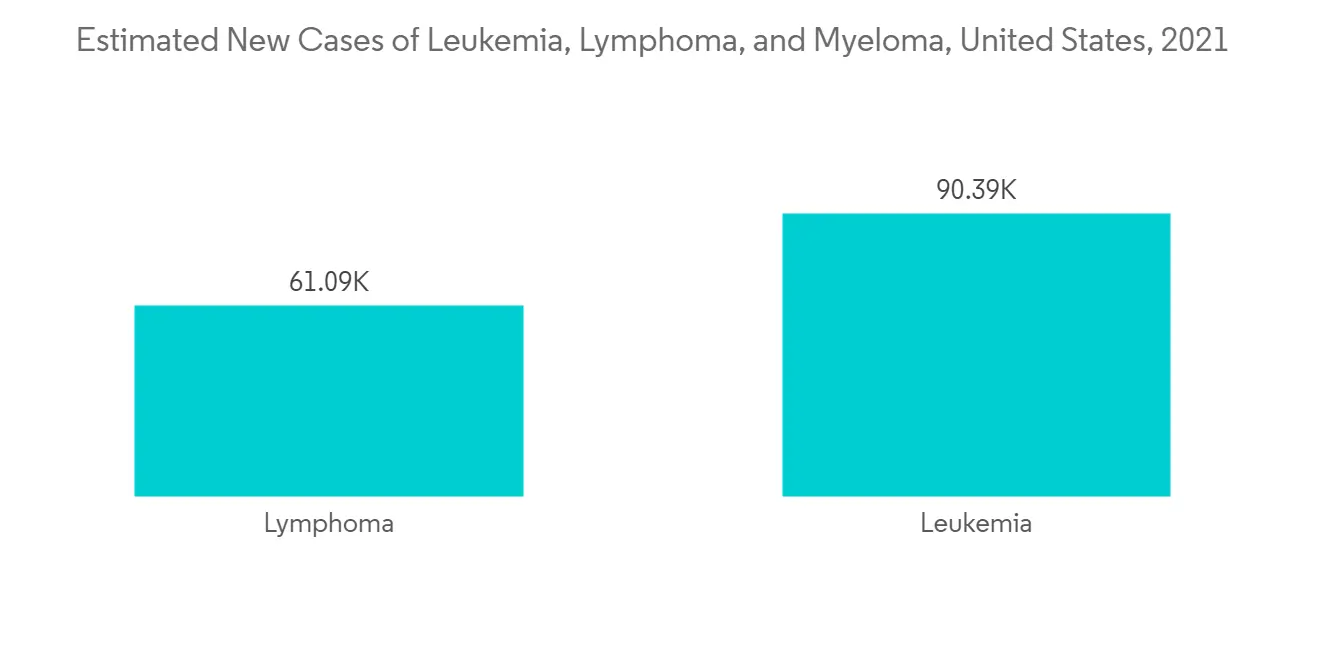
북미는 예측 기간 동안 큰 시장 점유율을 차지할 것으로 예상됩니다.
북미지역은 제약회사의 연구개발 활동 증가, 만성질환의 유병률 증가, HCS(High Content Screening) 방법의 기술적 진보로 인해 예측 기간 동안 HCS(High Content Screening) 시장에서 큰 시장 점유율을 차지할 것으로 예상됩니다.
미국암협회의 2022년 보고서에 따르면, 2022년 미국에서 약 1,918,030명의 신규 암 환자가 발생했습니다. 또한 캐나다 암 통계의 2021년 11월 보고서에 따르면, 캐나다인 5명 중 2명이 일생 동안 암 진단을 받았을 가능성이 있는 것으로 추정됩니다. 이에 따르면 2021년에 약 229,200명의 캐나다인이 암 진단을 받았습니다. 따라서 암의 높은 유병률은 제조 된 약물에 최고의 안전성과 효능을 제공하기 위해이 지역의 고 함량 스크리닝 시장을 촉진할 것으로 예상됩니다.
환자들 사이에서 심혈관 질환이 증가함에 따라 다양한 유전성 심혈관 질환에 대한 효과적인 치료제의 필요성과 수요가 더욱 증가하고 있습니다. 예를 들어, 미국심장협회는 2021년 미국 내 심부전 유병률이 6억 명으로 전체 인구의 1.8%에 해당한다고 보고했습니다. 이는 미국에서 조사된 시장 성장의 주요 촉진요인 중 하나가 될 것으로 예상됩니다.
따라서 암과 만성질환의 높은 유병률로 인해 약효를 높이기 위한 고함량 검진에 대한 수요가 증가하는 등 위의 요인으로 인해 고함량 검진 시장은 예측 기간 동안 북미에서 큰 폭의 성장을 보일 것으로 예상됩니다.

고함량 선별 산업 개요
HCS(High Content Screening)(HCS) 시장 경쟁은 중간 정도입니다. 화합물 프로파일링 응용 분야에서 많은 제약회사들이 신약 개발의 잠재적 후보 물질을 식별하기 위해 위탁 연구 기관과 협력하고 있으며, HCS 시장은 원래 경쟁이 치열합니다. 이 시장의 주요 기업으로는 애질런트 테크놀로지(Agilent Technology), 사이티바(Cytiva), BD(Becton Dickinson and Company), 바이오 래드 연구소(Bio-Rad Laboratories), 써모피셔 사이언티픽(Thermo Fisher Scientific) 등이 있습니다.
기타 혜택 :
기타 혜택- 엑셀 형식 시장 예측(ME) 시트
- 3개월간의 애널리스트 지원
목차
제1장 서론
- 조사 전제와 시장 정의
- 조사 범위
제2장 조사 방법
제3장 주요 요약
제4장 시장 역학
- 시장 개요
- 시장 성장 촉진요인
- 시장 성장 억제요인
- Porter의 Five Forces 분석
- 신규 진출업체의 위협
- 구매자/소비자의 교섭력
- 공급 기업의 교섭력
- 대체품의 위협
- 경쟁 기업간 경쟁 관계
제5장 시장 세분화(시장 규모 : 백만 달러)
- 제품별
- 기기
- 세포 이미징 및 분석 시스템
- 유세포 분석기
- 소모품
- 시약 및 어세이 키트
- 마이크로플레이트
- 기타 소모품
- 소프트웨어
- 서비스
- 기기
- 용도별
- 1차 및 2차 스크리닝
- 타겟 식별 및 밸리데이션
- 독성 시험
- 화합물 프로파일링
- 기타 용도
- 최종사용자별
- 제약 기업 및 바이오테크놀러지 기업
- 학술 및 정부기관
- 수탁 연구기관
- 지역별
- 북미
- 미국
- 캐나다
- 멕시코
- 유럽
- 독일
- 영국
- 프랑스
- 이탈리아
- 스페인
- 기타 유럽
- 아시아태평양
- 중국
- 일본
- 인도
- 호주
- 한국
- 기타 아시아태평양
- 중동 및 아프리카
- GCC
- 남아프리카공화국
- 기타 중동 및 아프리카
- 남미
- 브라질
- 아르헨티나
- 기타 남미
- 북미
제6장 경쟁 구도
- 기업 개요
- Danaher Corporation
- Perkinelmer Inc.
- Thermo Fisher Scientific Inc.
- BD(Becton, Dickinson and Company)
- Agilent Technologies
- Bio-Rad Laboratories Inc.
- Yokogawa Electric Corporation
- Merck KGaA
제7장 시장 기회와 향후 동향
LSH 23.08.16
The High-content Screening Market is poised to grow at a CAGR of 8.74% over the forecast period.
The outbreak of COVID-19 has turned the spotlight on the high-content screening market as most biopharmaceutical players were engaged in the development of novel therapeutics against the SARS-CoV-2 virus. Due to the increase in drug discovery, there was an increasing demand for drug testing products and services to monitor and evaluate the toxicity of a specific vaccine before commercializing it to the market. Due to this, the pandemic had a positive impact on the high-content screening market. According to the research article published in the American Chemical Society Pharmacology and Translational Science in 2020, new potential therapeutics for COVID-19 identified with a combined virtual and experimental screening strategy and selected from among the already approved drugs were studied to screen for structural similarity against a library of almost 4000 approved drugs with hydroxychloroquine (HCQ) as a reference drug. The study proposed zuclopenthixol, nebivolol, and amodiaquine as potential candidates for clinical trials against the early phase of the SARS-CoV-2 infection and remdesivir and favipiravir therapeutics as potential adjuvants in COVID-19 treatment. With the rising use of high-content screening for such studies, COVID-19 significantly impacted the market studied. The market is expected to show stable growth during the forecast period.
The need for cost containment in pharmaceutical research and development, advancements in informatics solutions and imaging instruments, and government funding and venture capital investments across developed markets are the major factors driving the growth of the High-Content Screening (HCS) Market.
Under the conventional method of toxicity studies, large libraries are screened in search of potential drug candidates. The traditional way is expensive, resource- and time-consuming, and it has a low success rate. Consequent High-Content Screening (HCS) solutions for testing the potential toxicity of chemicals and complex substances are being adopted by pharmaceutical companies to improve in-vitro toxicity testing by reducing the time and cost. The increasing number of contract research organizations providing HCS outsourcing services and the application of HCS in personalized medicine present significant growth opportunities in the market.
The recent technological developments by the market players and researchers, rising investments, and rising research and development activities worldwide are contributing to the growth of the studied market. For instance, in October 2021, BD Life Sciences-Biosciences launched its second Center of Excellence (CoE) in flow cytometry for clinical research in India in collaboration with Christian Medical College, Vellore. The partnership will allow hematologists, doctors, and lab professionals from all over India to deliberate and discuss standardization and best practices in clinical flow cytometry. This CoE will function as the National Reference Center for clinical diagnostics applications and is estimated to propel the High-Content Screening Market during the forecast period.
Furthermore, in April 2022, CytoTronics received USD 9.25 million in initial seed funding led by Anzu Partners, with participation from Milad Alucozai (BoxOne Ventures) and institutional investors. This funding will allow the company to commercialize its research-demonstrated devices for cell-based drug screening in multiple areas, such as oncology, gastroenterology, cardiology, and neurology. It is likely to expand its offerings in terms of bringing technologically advanced products to the market for drug screening purposes which is expected to propel the High-Content Screening Market during the forecast period.
Hence, with the factors such as rising healthcare investment, and increasing strategic initiatives by key players, it is believed that the market studied will witness healthy growth over the forecast period.
High Content Screening Market Trends
Flow Cytometry is Expected to Hold a Significant Market Share Over The Forecast Period
Flow cytometry is used in many research and clinical laboratories. Previously, flow cytometry was significantly restricted because of its limitations in handling scores of samples. However, with unparalleled advances in cell-based analysis and screening in recent years, this technique has been utilized as a powerful screening tool.
Various studies are done that deploy flow cytometry in research laboratories which are expected to propel the segment utility. Its primary users are immunologists and hematologists, who use it for cell sorting and analysis. For instance, a research study published in Frontiers in Immunology in February 2022, was conducted to develop a flow cytometric procedure for quantitative expression profiling of surface antigens on blood leukocyte subsets that are standardized across multiple research laboratories. The process, bioinformatics pipeline, and improved flow panels enable benchmarking new antibody clones to established CD markers and mapping the expression patterns of mAb clones with HLDA approval to CD markers. The advantages of flow cytometry, like the high-speed quantitative and high-content analysis of cells, make the technique an attractive technology for drug discovery applications. The rising research studies using flow cytometry and its advantages are expected to propel the segment growth during the analysis period.
Various market players are engaged in strategic initiatives such as product launches, partnerships, and innovation in technology to develop an advanced solution in the flow cytometry segment. For instance, in March 2022, Beckman Coulter Life Sciences launched the CellMek SPS solution to manual sample preparation and data management bottlenecks in clinical flow cytometry. The fully automated sample preparation system (SPS) offers on-demand processing to assist laboratories in enhancing their capabilities. Such launches are expected to propel the segment growth during the forecast period.
Therefore, flow cytometry is becoming an ideal tool, particularly in an environment where primary cell-based assays are increasingly being deployed to monitor drug responses. The increasing use of phenotypic cell-based assays in drug discovery and the need to monitor drug responses are major factors for the growth of flow cytometry. Therefore, the usage is expected to increase in the coming years. Additionally, the utilization of flow cytometry in the detection of cancer is further augmenting the growth of the segment.

North America is Expected to North America is Expected to Hold a Significant Market Share Over The Forecast Period
North America is expected to have a significant market share over the forecast period in the high-content screening market due to the growing research and development activities by pharmaceutical companies, the growing prevalence of chronic diseases in the country, and increasing technological advancements in high-content screening methods.
According to the American Cancer Society's 2022 report, about 1,918,030 new cancer cases were estimated in 2022 in the United States. Also, according to the Canadian Cancer Statistics November 2021 report, an estimated 2 in 5 Canadians were likely to be diagnosed with cancer in their lifetime. It stated that an estimated 229,200 Canadians was predicted to be diagnosed with cancer in 2021. Thus, the high prevalence of cancer is expected to boost the high-content screening market in the region for providing the best safety and efficacy to the manufactured drugs.
The increasing number of cardiovascular diseases among patients further increases the need and demand for effective therapeutics for various inherited cardiovascular conditions. For instance, the prevalence rate of heart failure in the United States is 6 million, which is 1.8% of its total population, as reported by the American Heart Association in 2021. This is expected to be one of the major driving factors for the growth of the market studied in the United States.
Therefore, owing to the factors mentioned above, such as the high prevalence of cancer and chronic diseases boosting the demand for high-content screening for boosting drug efficacy, the high-content screening market is expected to witness substantial growth in North America during the forecast period.
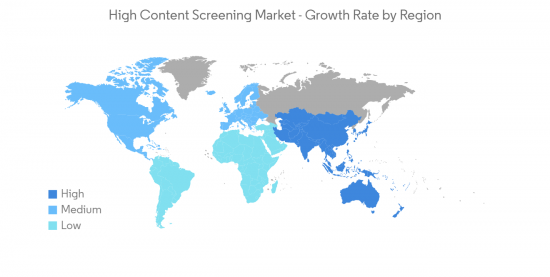
High Content Screening Industry Overview
The Market for High Content Screening (HCS) is moderately competitive. For compound profiling applications, many pharmaceutical companies are partnering with contract research organizations to identify potential candidates for drug discovery. The HCS market is highly competitive in nature. Some of the key companies in the market are Agilent Technologies, Cytiva, BD (Becton, Dickinson and Company), Bio-rad Laboratories, and Thermofisher Scientific, among others.
Additional Benefits:
- The market estimate (ME) sheet in Excel format
- 3 months of analyst support
TABLE OF CONTENTS
1 INTRODUCTION
- 1.1 Study Assumptions and Market Definition
- 1.2 Scope of the Study
2 RESEARCH METHODOLOGY
3 EXECUTIVE SUMMARY
4 MARKET DYNAMICS
- 4.1 Market Overview
- 4.2 Market Drivers
- 4.2.1 Government Funding and Venture Capital Investments Across Developed Markets
- 4.2.2 Increasing Applications of High Content Screening in Life Science Research
- 4.2.3 Advancements in Informatic Solutions and Imaging Systems
- 4.3 Market Restraints
- 4.3.1 Lower Adoption of High Content Screening Instruments Due to Their High Prices
- 4.4 Porter's Five Forces Analysis
- 4.4.1 Threat of New Entrants
- 4.4.2 Bargaining Power of Buyers/Consumers
- 4.4.3 Bargaining Power of Suppliers
- 4.4.4 Threat of Substitute Products
- 4.4.5 Intensity of Competitive Rivalry
5 MARKET SEGMENTATION (Market Size by Value - USD million)
- 5.1 By Product
- 5.1.1 Instruments
- 5.1.1.1 Cell Imaging and Analysis Systems
- 5.1.1.2 Flow Cytometers
- 5.1.2 Consumables
- 5.1.2.1 Reagents and Assay Kits
- 5.1.2.2 Microplates
- 5.1.2.3 Other Consumables
- 5.1.3 Software
- 5.1.4 Services
- 5.1.1 Instruments
- 5.2 By Application
- 5.2.1 Primary and Secondary Screening
- 5.2.2 Target Identification and Validation
- 5.2.3 Toxicity Studies
- 5.2.4 Compound Profiling
- 5.2.5 Other Applications
- 5.3 By End User
- 5.3.1 Pharmaceutical and Biotechnology Companies
- 5.3.2 Academic and Government Institutions
- 5.3.3 Contract Research Organization
- 5.4 Geography
- 5.4.1 North America
- 5.4.1.1 United States
- 5.4.1.2 Canada
- 5.4.1.3 Mexico
- 5.4.2 Europe
- 5.4.2.1 Germany
- 5.4.2.2 United Kingdom
- 5.4.2.3 France
- 5.4.2.4 Italy
- 5.4.2.5 Spain
- 5.4.2.6 Rest of Europe
- 5.4.3 Asia-Pacific
- 5.4.3.1 China
- 5.4.3.2 Japan
- 5.4.3.3 India
- 5.4.3.4 Australia
- 5.4.3.5 South Korea
- 5.4.3.6 Rest of Asia-Pacific
- 5.4.4 Middle East and Africa
- 5.4.4.1 GCC
- 5.4.4.2 South Africa
- 5.4.4.3 Rest of Middle East and Africa
- 5.4.5 South America
- 5.4.5.1 Brazil
- 5.4.5.2 Argentina
- 5.4.5.3 Rest of South America
- 5.4.1 North America
6 COMPETITIVE LANDSCAPE
- 6.1 Company Profiles
- 6.1.1 Danaher Corporation
- 6.1.2 Perkinelmer Inc.
- 6.1.3 Thermo Fisher Scientific Inc.
- 6.1.4 BD (Becton, Dickinson and Company)
- 6.1.5 Agilent Technologies
- 6.1.6 Bio-Rad Laboratories Inc.
- 6.1.7 Yokogawa Electric Corporation
- 6.1.8 Merck KGaA





